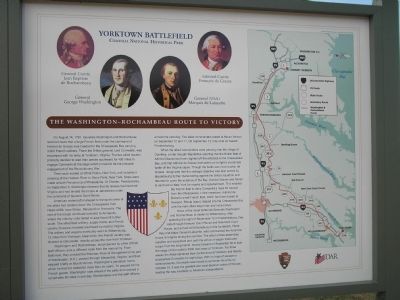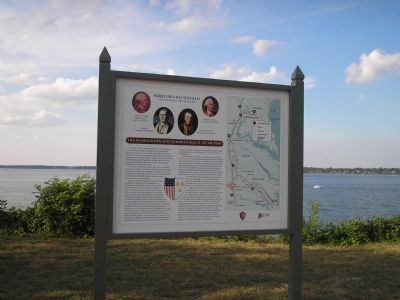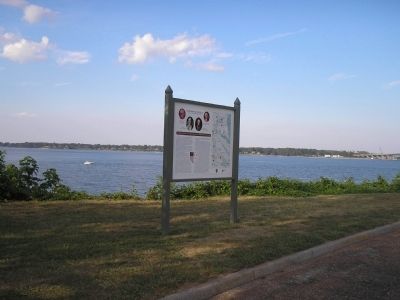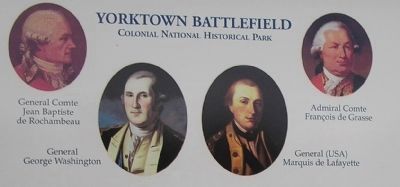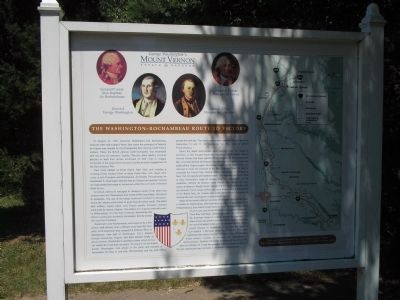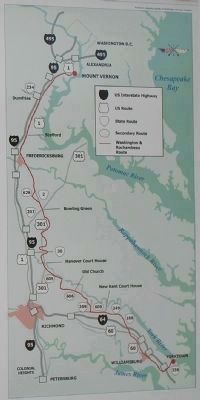Yorktown in York County, Virginia — The American South (Mid-Atlantic)
The Washington – Rochambeau Route to Victory
Yorktown Battlefield
— Colonial National Historical Park —
Inscription.
On August 14, 1781, Generals Washington and Rochambeau received news that a large French fleet under the command of Admiral de Grasse was headed for the Chesapeake Bay carrying 3,000 French soldiers. There the British general, Lord Cornwallis, was encamped with his army at Yorktown, Virginia. The two allied leaders promptly decided to lead their armies southward for 450 miles to engage Cornwallis at the siege which proved to be the pinnacle engagement of the Revolutionary War.
Their route started at White Plains, New York, and included a crossing of the Hudson River at Stony Point, New York. Stops were made at both Princeton and Philadelphia. At Chester, Pennsylvania, on September 5, Washington learned that de Grasse had reached Virginia and had landed the troops at Jamestown under the command of General Saint-Simon.
American watercraft managed to transport some of the allied foot soldiers down the Chesapeake from Head-of-Elk (now Elkton, Maryland) to Annapolis. The rest of the troops continued overland to Annapolis, where the infantry units halted to await boat lift further south. The allied field artillery, supply trains, and French cavalry (hussars) traveled southward by road to Virginia. The artillery and wagons eventually went to Williamsburg, 12 miles from Yorktown. Meanwhile, the French cavalry was diverted to Gloucester, directly across the river from Yorktown.
Washington and Rochambeau, accompanied by a few of their staff officers, took a different route from the main army. From Baltimore, they crossed the Potomac River at Georgetown (now part of Washington, D.C.), passed through Alexandria, Virginia, and then stopped briefly at Mount Vernon, Washington’s plantation home, which he had not visited for more than six years. To prepare for his French guests, Washington rode ahead of the party and covered a remarkable 60 miles in one day. Rochambeau and the staff officers arrived the next day. The allied commanders rested at Mount Vernon on September 10 and 11. On September 12, they rode on toward Fredericksburg.
When the allied commanders were passing near the village of Dumfries, a rider brought dispatches reporting that the British fleet of Admiral Graves had been sighted off the entrance to the Chesapeake Bay, and that Admiral de Grasse had sailed off to fight a crucial sea battle off the Virginia capes. Though the battle was inconclusive, de Grasse recognized that the strategic objective was best served by discontinuing further maneuvering against the British squadron and returned to cover the entrance of the Bay. Admiral Graves was forced to sail back to New York for repairs and replenishment. This enabled the French fleet to deny Cornwallis’s hope for escape from the Chesapeake. In the meantime, Admiral De Barras’s small French fleet, which had been based at Newport, Rhode Island, slipped into the Chesapeake Bay with the main allied siege train and more troops.
News of the naval battle led Generals Washington and Rochambeau to hasten to Williamsburg. After spending the night of September 12 in Fredericksburg, they rode through Hanover Court House and New Kent Court House, and arrived at Williamsburg on the fourteenth. There they met General Lafayette, who commanded the American forces in Virginia during the summer. The allied armies assembled supplies and equipment and, with the arrival of wagon trains and troops from the long march, moved forward on September 28 to start the siege of Cornwallis’s 8300 man army at Yorktown. For three weeks the Allies tightened their control around Yorktown and heavily bombarded Cornwallis for eight days. With no hope of escape or reinforcements, Cornwallis was forced to surrender his army on October 19. It was the greatest and most decisive victory of the war, leading the way inevitably to American Independence.
Erected by Colonial National Historical Park, National Park Service and The Virginia Daughters of the American Revolution.
Topics and series. This historical marker is listed in these topic lists: Notable Events • Notable Places • War, US Revolutionary. In addition, it is included in the Daughters of the American Revolution, the Former U.S. Presidents: #01 George Washington, and the The Washington-Rochambeau Route series lists. A significant historical month for this entry is September 1638.
Location. 37° 14.442′ N, 76° 31.263′ W. Marker is in Yorktown, Virginia, in York County. Marker is on Fusiliers Redoubt ramp, on the left when traveling east. Touch for map. Marker is in this post office area: Yorktown VA 23690, United States of America. Touch for directions.
Other nearby markers. At least 8 other markers are within walking distance of this marker. French Trench (within shouting distance of this marker); Fusiliers Redoubt (about 300 feet away, measured in a direct line); a different marker also named French Trench (about 400 feet away); Washington-Rochambeau Route (about 700 feet away); Naval Weapons Station (approx. half a mile away); The Yorktown Windmill (approx. 0.6 miles away); John Smith Explores the Chesapeake (approx. 0.6 miles away); Join the Adventure (approx. 0.6 miles away). Touch for a list and map of all markers in Yorktown.
More about this marker.
A shield of the American and French flags appears in the center of the marker. The top of the marker features portraits of two American and two French leaders at Yorktown. A map showing the route taken by Washington and Rochambeau from Mount Vernon to Yorktown appears on the right of the marker.
Related markers. Click here for a list of markers that are related to this marker. 'Sister' displays in Virginia commemorating the route taken by Generals Washington and Rochambeau, to Yorktown in September 1781.
Also see . . .
1. Yorktown Battlefield. National Park Service. (Submitted on September 2, 2008, by Bill Coughlin of Woodland Park, New Jersey.)
2. The Battle of Yorktown. The Patriot Resource website. (Submitted on September 2, 2008, by Bill Coughlin of Woodland Park, New Jersey.)
3. The Battle of Yorktown 1781. A British perspective of the Battle of Yorktown from BritishBattles.com. (Submitted on September 2, 2008, by Bill Coughlin of Woodland Park, New Jersey.)
Credits. This page was last revised on June 16, 2016. It was originally submitted on September 2, 2008, by Bill Coughlin of Woodland Park, New Jersey. This page has been viewed 1,789 times since then and 19 times this year. Photos: 1, 2, 3, 4, 5, 6. submitted on September 2, 2008, by Bill Coughlin of Woodland Park, New Jersey.
